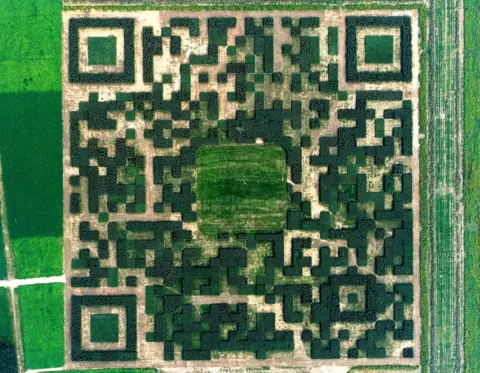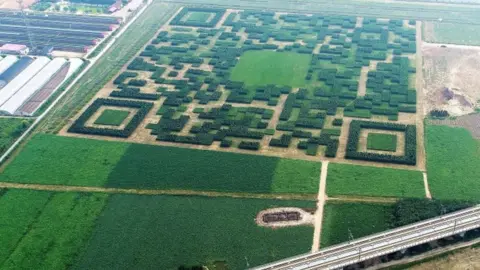Chinese maze: Village makes giant tech code from trees
 Xinhua/REX/Shutterstock
Xinhua/REX/ShutterstockAt first glance, it could be the courtly maze of an English country manor - albeit with some rather large gaps.
But a tech-savvy eye will instantly see the green design for what it is - a massive QR code.
These high-tech barcodes are hugely popular in China as a way to make cashless payments on a smartphone.
Xilinshui village, in the northern Hebei province, has created one from trees in a bid to raise its profile.
The design was made from 130,000 Chinese junipers, and can be scanned from above using a phone or tablet.
It is not clear how high above the trees you would have to be to scan it - or how you might get there - but visitors who successfully capture the code will be connected to the village's tourism account on WeChat, a Chinese social media site.
The vast design measures 227m (744ft) along each side, and the trees are between 80cm and 2.5m in height, the South China Morning Post reports.
Xilinshui was named "the most beautiful village in Hebei" in 2015, and received a 1.1 million yuan ($168,000; £124,00) development grant from the province.
How QR works
Chinese shoppers are increasingly using QR codes in their everyday lives, and especially for making quick payments. The little codes, made from a pattern of black-and-white squares, can store information - for example, the cost of an item, or cooking instructions for a food.
 Xinhua/REX/Shutterstock
Xinhua/REX/ShutterstockWaiters can sometimes be seen with QR badges pinned to their shirts, so happy customers can scan them to leave a tip.
Even beggars have been pictured displaying the codes to encourage donations.
Mammoth QR codes have been used to drum up business before. In 2013, Chinese developer Vanke built a striking 6,400 sq metre (20,000 sq ft) code near a housing construction site in Hefei, Anhui province. When scanned, it played sights and sounds designed to entice would-be homeowners.
